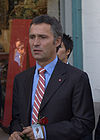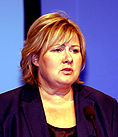- Norwegian parliamentary election, 2005
-
Norwegian Parliamentary election, 2005 
2001 ←
membersSeptember 12, 2005 → 2009 All 169 seats to the Norwegian Parliament
85 seats were needed for a majorityFirst party Second party Third party 


Leader Jens Stoltenberg Carl I. Hagen Erna Solberg Party Labour Party Progress Party Conservative Party Leader since 2002 1978 2004 Last election 43 seats (24.3%) 26 seats (14.6%) 38 seats (21.2%) Seats won 61 38 23 Seat change +18 +12 -15 Popular vote 862,757 582,284 372,008 Percentage 32.7% 22.1% 14.1%
Prime Minister before election
Kjell Magne Bondevik
Bondevik's Second CabinetPrime Minister-designate
Jens Stoltenberg
Red-Green CoalitionNorway 
This article is part of the series:
Politics and government of
NorwayMonarchyGovernmentParliamentLocal Gov'tForeign policy
Parliamentary elections were held in Norway on 12 September 2005. More than 3.4 million Norwegians were eligible for vote for the Storting, the parliament of Norway. The new Storting has 169 members, an increase of four over the 2001 election.
The election was won by the opposition centre-left Red-Green Coalition, which took 87 seats, dominated by the Labour Party's 61 seats. The three-party centre-right government coalition won 44 seats and the populist Progress Party won 38, becoming the largest opposition party. Voter turnout was 77.1 %, an increase of 2 percentage points compared to the 2001 elections.
Contents
Electoral Campaign
Before the election, Prime Minister Kjell Magne Bondevik led a coalition government consisting of the Conservative Party (38 seats in parliament), Christian People's Party (22 seats and supplied the prime minister) and the Liberals (2 seats), with the conditional support of the right-wing Progress Party. Between them, the three main parties of the coalition held 62 seats in the outgoing 165-seat Storting. The Progress Party held an additional 26, giving the four parties a majority when acting together.
Divisions within the coalition led to the temporary withdrawal of support by the Progress Party in November 2004, in response to what they saw as the government's underfunding of hospitals; an agreement was later reached. The government also attracted criticism for its handling of the 2004 Indian Ocean earthquake, in which several Norwegians died, with the prime minister admitting to mistakes in his government's delayed reaction to the disaster.
The question of private schools was controversial in 2005, with the opposition Labour Party, Socialist Left Party and Centre Party rejecting the government's plan to allow schools other than those offering an "alternative education", or those founded on religious beliefs, to become private.
Amidst a decline in the personal popularity of the prime minister, opinion polls in early 2005 indicated a clear lead for the Labour Party. Its leader, Jens Stoltenberg, was prime minister from March 2000 to October 2001, and enjoyed widespread public support in the run-up to the election. Polling suggests that the Labour, Socialist Left and Centre parties could form a red–green coalition, which would command a majority in the Storting. Labour and Socialist Left have pledged to maintain their allegiance with the Centre party even if the latter were not necessary to obtain a majority.
In June the leader of the Progress Party, Carl I. Hagen, said his party would not support a new coalition if Bondevik re-emerges as the prime minister after the election, implicitly pointing at Erna Solberg, leader of the conservative party as a better candidate.
A week before the elections, the Socialist Left Party experienced a fall in popularity on recent polls. The Liberals and Conservative Party gained popularity on the polls. As of September 11, 2005, the day before the election, the opinion polls indicated a dead run between the red-green coalition and the right wing.
Advance voting was possible from August 10 to September 9, 2005. 452,488 votes were cast in advance, a decrease of approx 52,000 since the 2001 election. [1]
Results
Summary of the 12 September 2005 Norwegian Storting election results Parties Votes Seats # % ± % # ± Norwegian Labour Party (Det norske Arbeiderparti) 862,757 32.7 +8.4 61 +18 Progress Party (Fremskrittspartiet) 582,284 22.1 +7.4 38 +12 Conservative Party (Høyre) 372,008 14.1 −7.1 23 −15 Socialist Left Party (Sosialistisk Venstreparti) 233,069 8.8 −3.7 15 −8 Christian Democratic Party (Kristelig Folkeparti) 178,889 6.8 −5.6 11 −11 Centre Party (Senterpartiet) 171,124 6.5 +0.9 11 +1 Liberal Party (Venstre) 156,081 5.9 +2.0 10 +8 Red Electoral Alliance (Rød Valgallianse) 32,365 1.2 0.0 0 0 Coastal Party (Kystpartiet) 21,946 0.8 −0.9 0 −1 Pensioners' Party (Pensjonistpartiet) 13,559 0.5 –0.2 0 0 Christian Unity Party (Kristent Samlingsparti) 3,865 0.1 –0.2 0 0 Environment Party The Greens (Miljøpartiet De Grønne) 3,652 0.1 0.0 0 0 The Democrats (Demokratene) 2,706 0.1 – 0 – Abortion Opponents' List (Abortmotstandernes Liste) 1,932 0.1 – 0 – Communist Party of Norway (Norges Kommunistiske Parti) 1,066 0.0 0.0 0 0 Reform Party (Reformpartiet) 727 0.0 – 0 – Sami People Party (Sámeálbmot bellodat, Samefolkets Parti) 660 0.0 0.0 0 0 Liberal People's Party (Det Liberale Folkeparti) 213 0.0 0.0 0 0 Norwegian Republican Alliance (Norsk Republikansk Allianse) 94 0.0 – 0 – Beer Unity Party (Pilsens Samlingsparti) 65 0.0 – 0 – Society Party (Samfunnspartiet) 43 0.0 0.0 0 0 2,639,105 100% 169 Winners
- The red-green coalition was the winner of the election and formed a majority government, with Jens Stoltenberg as prime minister, on October 17, 2005, as soon as a national budget for 2006 had been proposed by the old government.
- The Labour Party obtained a result that brought it back into the position of "the largest Norwegian party, not just the largest of many middle-sized ones".
- The Progress Party obtained its best result ever, surpassing the Conservatives by a large margin and becoming almost as large as the parties in the Bondevik government together.
- The Liberal Party gained a substantial amount of seats in its most successful election since 1965. The large number of additional seats won with only a modest gain in votes came partly as a result of passing the threshold of 4% of the votes required for a party to be allocated leveling seats to bring their representation into proportion to the overall national vote (as opposed to direct regional mandates allocated on the basis of number of votes in the specific region). Venstre got six direct regional mandates and four allocated additional mandates.
Losers
- Non-socialist parties suffered a defeat well beyond its numbers, with almost half of its votes for the Progress party, which had been able to offer only external support to the Bondevik government; the other parties shunned any possible formal inclusion in the government coalition over differing views in several issues.
- The Socialist Left Party obtained only a disappointing result, after polls that showed the party well beyond 15% at times during the electoral campaign.
- The Conservative Party lost a large share of votes and are no longer the largest non-Socialist party, surpassed by the Progress Party.
- The Christian Democratic Party almost halved its votes, and suffered one of the worst defeats ever.
- The Coastal Party lost its only representative in the parliament.
- The Red Electoral Alliance did not manage to obtain a seat in the parliament.
Further reading
- Sitter, Nick (May 2006). "Norway’s Storting Election of September 2005: Back to the Left?". West European Politics 29 (3): 573–580. doi:10.1080/01402380600620700.
References
- Complete, official results from the website of the Norwegian parliament, stortinget.no, in Norwegian.
- Leftist Coalition Seems to Be the Winner in Norway's Election. New York Times. September 13, 2005.
- Bondevik bows out. Aftenposten. 13 September 2005.
- Red-green alliance forges ahead. Aftenposten. 13 September 2005.
- Labour gains in new poll. Aftenposten. 5 September 2005.
- Labour stealing partner's votes. Aftenposten. 24 June 2005.
- Hagen won't back Bondevik. Aftenposten. 20 June 2005.
- Labour Down, Progress Party Surges in Norway. Angus Reid Consultants. 12 June 2005.
- Norway — Red–Green Alliance could get majority. Angus Reid Consultants. Retrieved 5 June 2005.
- Left wing alliance advances despite Labour retreat. Aftenposten. March 30, 2005.
- Labour soars in latest poll. Aftenposten, August 26, 2005.
 Elections and referendums in Norway
Elections and referendums in NorwayParliamentary elections Eidsvoll 1814 · 1814 · 1815 · 1817 · 1820 · 1823 · 1826 · 1829 · 1832 · 1835 · 1838 · 1841 · 1844 · 1847 · 1850 · 1853 · 1856 · 1859 · 1862 · 1865 · 1868 · 1870 · 1873 · 1876 · 1879 · 1882 · 1885 · 1888 · 1891 · 1894 · 1897 · 1900 · 1903 · 1906 · 1909 · 1912 · 1915 · 1918 · 1921 · 1924 · 1927 · 1930 · 1933 · 1936 · 1945 · 1949 · 1953 · 1957 · 1961 · 1965 · 1969 · 1973 · 1977 · 1981 · 1985 · 1989 · 1993 · 1997 · 2001 · 2005 · 2009 · 2013Local elections Sami elections Referendums Categories:- Elections in Norway
- 2005 elections in Europe
- 2005 in Norway
Wikimedia Foundation. 2010.


